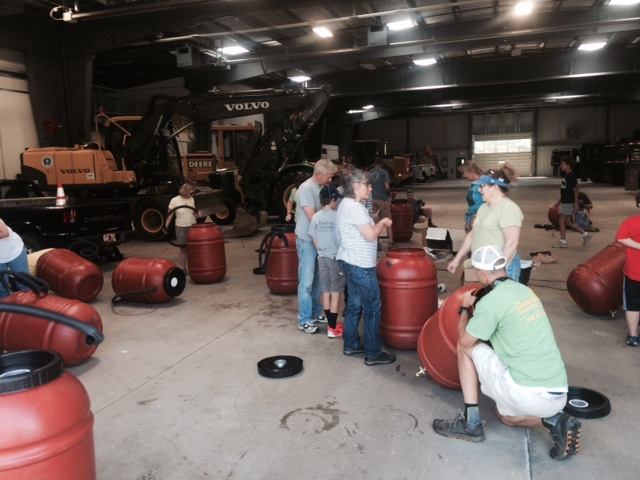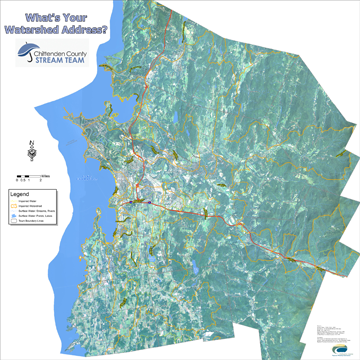
Diner Croisière Seine
Connecting the Drops Rain Barrel Exhibit and "Build a Rain Barrel" Workshop coming to Milton!
For its fourth anniversary, the Connecting the Drops traveling Rain Barrel Exhibit will be held at the Milton Farmers Market, adjacent to the Hannaford Plaza in Milton, VT, from June 9th – July 7th. As in years prior, this display will feature original art by local artists using rain barrels as the canvas! During the exhibit Chittenden County residents will have a chance to sign up and win one of the five, uniquely-decorated rain barrels for use at their own home or work.
he purpose of the exhibit is to raise awareness about stormwater runoff and the actions property owners can take reduce stormwater and its negative impact on our waterways. The art-adorned rain barrels will be given away to lucky winners at the July 7th Farmers Market. You can enter for a chance to win in either of two ways: by scanning the QR code at the exhibit between June 9th – July 7th.

For an idea of how the display will look, here's a photo from 2015's Connect the Drops 3.0 in Williston
In addition to exploring the beautiful artistic display, visitors will have the chance to read the Kids VT “Stormwater Story”; a tale created by parenting magazine Kids VT that relays how stormwater impairs natural waterways and what each of us can do to “slow, spread, and sink” stormwater.
><><><><><><><><
For those with an interest in hands-on learning, the Chittenden County Stream Team (CCST) will also host a Build-A-Rain Barrel Workshop at Milton’s Freedom Fest! See below for details about the event and how to register:
Create Your Own Rain Barrel Workshop at Milton’s Freedom Fest!
Date: Sat, June 25
Time: 3-4pm
Location: Field House in Bombardier Park West, Milton
Fee: $30/rain barrel

CALL FOR RAIN GARDEN VOLUNTEERS!
Are you interested in helping to prevent stormwater from negatively impacting Lake Champlain by maintaining a rain garden? The Adopt-a-Rain Garden Program is an opportunity for individuals to assist in keeping Chittenden County's public rain gardens clean and attractive by performing basic maintenance activities like picking up litter, pulling weeds, and installing new mulch. One rain garden in particular that needs a new caretaker is the Brownell Library rain garden in Essex Junction.
Resources
Regional Stormwater Education Program
Vermont Rain Garden Manual
Rain Garden App - A free mobile app for designing, installing, and maintaining a rain garden
Vermont Low Impact Development Guide for Small Sites
New Hampshire Residential Guide for Stormwater Management
Diner croisiere paris
EPA Low Impact Development Site
NRCS Web Soil Survey
My Watershed
A watershed is an area of land where all water travels to the lowest point - a river, stream or lake. Water slides down the sides of the area from the highest point to the bottom of the watershed, like rain falling in a large bowl or basin. On its way, the water travels over the land, across fields, forest, lawns and city streets. A portion of this water seeps into the soil and travels under ground (called ground water). The portion that stays above ground is what most concerns us when we talk about stormwater, especially when this water flows over impervious surfaces such as roof tops and driveways. It is this water that collects and transports debris, chemicals, sediment and pathogens. When these things enter our waterways, they have a lasting effect on both human and environmental health.
To see if you live in an impaired watershed, browse the map below.
You may also click below for a static version of this map.

Volunteer Opportunities
If you are interested in volunteering, there are a number of ways to get involved.
Become a Team Leader
Team Leaders work at the local level. We rely on them to help identify projects, mentor new volunteers, and promote events and workshops.
Test Water Quality and Quantity
We have a robust stream monitoring program that has relied on volunteers to take water samples for the last two years. The data collected helps to guide our project selection process. Volunteers are needed on a yearly basis during the summer months to collect water samples and gather data. Volunteers are recruited in the late spring and trained before testing begins in early summer.
Adopt-a-Rain Garden
Rain Gardens are one of the ways that individuals, businesses, and municipalities can mitigate stormwater. They are a landscaped depression designed to retain and treat stormwater. A number of rain gardens have been built for this purpose. The Adopt-a-Rain Garden Program is designed to keep these gardens functional and attractive.
Help Cleanup Your Local Rivers
You can do your part to keep our rivers healthy by helping out during a scheduled river cleanup.
Restore a Stream
Typically in the Spring and Summer, CCST and other partners will restore rivers and streams through the planting of riparian buffers and stabilization of eroding banks. This process is fairly labor intensive and volunteers are always needed.
Stream Monitoring
Stream monitoring is an important component of stormwater mitigation. Consistent data related to water quality and quantity allows stormwater managers to better assess the state of our waters and develop solutions that will have a lasting positive effect. Volunteers are typically used to collect samples at a variety of locations along a stream or within a watershed. These samples are sent to a lab and analyzed. On occasion, volunteers may also gather visual data as to the condition of a stream. Data collected in this way may include presence or absence of riparian buffers, streambank stability, and presence of litter or trash.
Wheeler Nature Park
View CCST Water Quality Monitoring in a larger map
Annual Reports on Water Quality
Each year, after the volunteer water quality monitoring is completed, the Chittenden County Stream Team compiles a report that we share with the Vermont Department of Environmental Conservation. Copies of those reports can be found below:
CCST's 2012 Annual Water Quality Monitoring Report
CCST's 2013 Annual Water Quality Monitoring Report
CCST's 2014 Annual Water Quality Monitoring Report
CCST's 2015 Annual Water Quality Monitoring Report
Which Pollutants/Nutrients does the Stream Team Monitor?
Phosphorus
Phosphorus is an essential nutrient for plants and animals in the aquatic food web and is naturally limited in most fresh waters; therefore, even a modest increase can set off a chain of undesirable events. Such events include algal blooms, accelerated plant growth, low dissolved oxygen, and death of aquatic animals. Phosphorus naturally occurs in soils and rocks. Additional phosphorus enters waterways through runoff from wastewater treatment plants fertilized lawns and cropland, failing septic systems, animal manure storage areas, pet waste and from erosion.
The Vermont Water Quality Standards currently set no specific standard for phosphorus levels in Class B waters below 2500 feet in elevation. The State of Vermont has proposed amendments to the water quality standards to set a limit of 27 µg/L for Class B warm water medium-gradient streams. Phosphorus concentrations exceed the proposed standards at all sites measured.
Nitrogen
The Stream Team monitored Nitrogen in 2012 and 2013. However, due to the low levels present in all samples, we did not continue monitoring for Nitrogen in 2014 and beyond.
Nitrogen exists in water in numerous forms, two of which are nitrate (NO3) and nitrite (NO2). Of these two forms, nitrate is usually the most important to measure because it is more commonly found in surface waters. Nitrate is an essential nutrient for growth of algae and other aquatic plants, and can be present at high levels due to a variety of sources. Sources of nitrogen in waters can come from wastewater treatment plants, runoff from fertilized lawns and cropland, failing on-site septic systems, runoff from animal manure storage areas, and industrial discharges. The Vermont Water Quality Standards standard for Nitrogen in Class B waters is 5.0 mg NO3-N/L. None of the site exceed the standard for Nitrogen recommended by the state.
Chloride
Chloride is a component of salt found naturally in minerals and in oceans. Elevated chloride levels in surface waters can lead to poor health and reduced reproduction in aquatic species, according to the Vermont Surface Water Management Strategy. The sources of chloride in water include road deicing salts, wastewater form industries and municipalities, and leachate from landfills. The current water quality standard for chloride is 230 mg/L. The highest chloride concentration measured by the Stream Team was found at Centennial Brook in 2012, with a reading of 468 mg/L
Turbidity
The turbidity of a water sample refers to its cloudiness. This measurement is based on the amount of algae, microbes, and sediment suspended in the water. Turbidity measurements can be used as an indicator for erosion and/or nutrient concentration. Higher turbidity levels can indicate a higher chance of disease-causing organisms being present. The Vermont Water Quality Standards state that turbidity should not exceed 10 NTU (nepholometric turbidity units) in cold-water fish habitat and 25 NTU in warm-water fish habitat. The highest turbidity levels observed were in Morehouse Brook in 2013, with a measurement of 182 NTU, however the annual average measurement for 2013 was 42.75 NTU.
TSS (Total Suspended Solids)
Suspended solids are defined as particles that will not pass through a 2-micron filter; these particles include: silt, clay, plankton, algae, fine organic debris, and other particulate matter. High concentrations of suspended solids in a waterbody can potentially carry pollutants that cling to suspended particles, such as pesticides from crops. Like turbidity, total suspended solids impact water clarity, which makes it harder for light to pass through the water and therefore decreases photosynthesis. Water with a high concentration of TSS warms more rapidly and holds less oxygen, altering the aquatic habitat. The sources of TSS include industrial discharge, sewage, fertilizers, road runoff, and soil erosion. TSS is measured as a weight of TSS per volume of water (mg/L). There are no quantitative criteria for TSS. Vermont Water Quality Standards state that TSS concentrations "should not exceed an amount that would prevent the full support of uses."
E. coli
Escherichia coli (E. coli) is a species of fecal coliform bacteria that is specific to fecal material from humans and other warm-blooded animals. The microbes can cause short-term health effects such as diarrhea, cramps, nausea, headaches, and other symptoms. E. coli exposure may pose special health risk for infants, young children, and people with severely compromised immune systems. The Vermont Water Quality Standards state that E. coli exceed a geometric mean based on at least 3 samples obtained over a 30 day period of 18 organisms/100 ml; the Vermont safe standard for E. coli in recreational waters is 77 colonies per 100ml. Currently, the Stream Team only monitors E. coli data at Wheeler Nature Park.